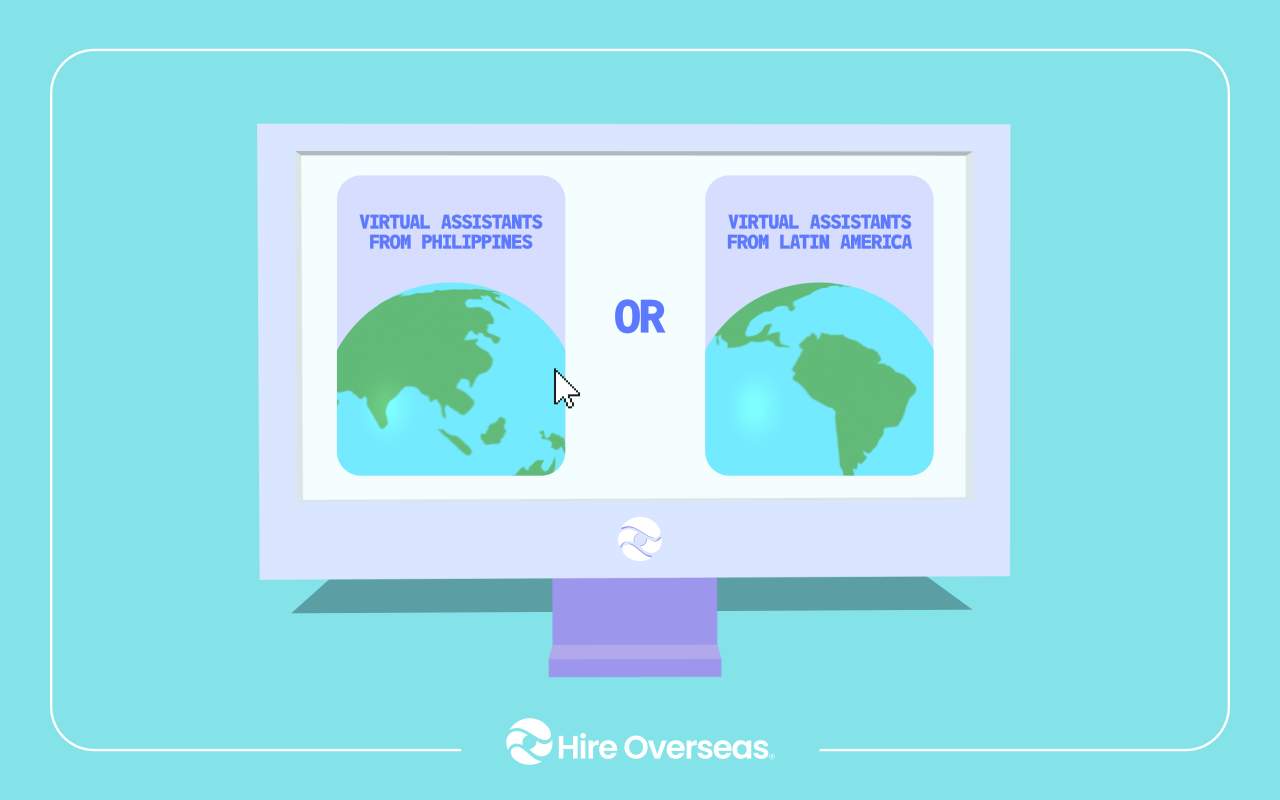Philippines vs Latin America Virtual Assistants: What U.S. Companies Need to Know

As remote work expands across the U.S., two global regions consistently emerge as top destinations for hiring virtual assistants: the Philippines and Latin America. Both regions offer large, skilled labor pools, strong cultural alignment with U.S. businesses, and significantly lower hiring costs than domestic employment.
Instead of deciding which region is “better,” U.S. companies benefit more from understanding the evidence-based strengths of each talent market—rooted in education systems, language proficiency, workforce backgrounds, wage structures, and outsourcing maturity.
This guide breaks down what U.S. companies need to know, backed by facts.
Why U.S. Businesses Compare These Two Regions
U.S. companies consistently evaluate the Philippines and Latin America side by side because both regions share structural conditions that make them ideal for remote staffing. These common advantages create strong, predictable outcomes for businesses outsourcing administrative, operational, and customer-facing tasks.
Large, Educated Workforces
Both regions produce substantial numbers of college graduates annually in fields that directly support virtual assistant functions such as business administration, IT, communications, education, and marketing.
- The Philippines has long been a top global supplier of service-industry talent due to its BPO concentration and English-based education system.
- Latin American countries like Colombia, Mexico, and Argentina have expanding university systems and are increasingly recognized for their business, engineering, and creative graduates.
This ensures a steady supply of professionals equipped for remote work roles.
Growing Service-Sector Economies
Service-sector growth in both regions is accelerating due to digital transformation and global outsourcing demand.
- The Philippines has a multi-billion-dollar BPO industry employing millions.
- Latin America’s nearshore outsourcing sector continues to expand as more U.S. companies seek bilingual and time-zone–aligned talent.
This economic focus means more workers are trained specifically for operational, administrative, and customer support roles—core functions handled by virtual assistants.
Familiarity With Western Communication Norms
Decades of exposure to U.S. media, education materials, and business clients have shaped communication styles in both regions.
- In the Philippines, U.S. cultural influence is widespread due to historical ties and an English-based school system.
- In Latin America, increasing participation in global industries—especially technology, hospitality, e-commerce, and customer service—has strengthened workers’ comfort with U.S. communication expectations.
This helps reduce friction in daily collaboration, tone, and workflow exchanges.
Strong Adoption of Remote Work Tools
Both regions have seen rapid adoption of digital tools such as:
- project management platforms (Asana, Trello, ClickUp)
- CRMs (HubSpot, Salesforce)
- communication tools (Slack, Teams, Zoom)
- e-commerce and workflow platforms
This familiarity comes from widespread use in outsourcing industries, freelancing sectors, and multinational companies operating in these markets.
As a result, virtual assistants from these regions typically require minimal onboarding for tool-related tasks.
Cost-Effective Labor Markets
Local wage structures, cost of living, and large talent pools allow U.S. companies to hire skilled professionals at significantly lower costs than domestic hiring.
- The Philippines offers some of the most competitive labor rates in Asia.
- Latin America provides affordable bilingual and real-time collaboration support compared to U.S. staffing costs.
This combination of affordability and skill makes both regions attractive for businesses seeking efficient, scalable remote teams.
Why This Matters for U.S. Companies
Because both the Philippines and Latin America offer these shared advantages, U.S. businesses often compare them directly to determine:
- which region aligns better with their time zone needs
- whether bilingual capability is important
- whether the work requires real-time collaboration or structured workflows
- how many roles they need to scale cost-effectively
- whether the background of each region’s workforce matches job requirements
These overlapping strengths explain why both regions dominate conversations about the best places to hire virtual assistants overseas.
Strengths of Virtual Assistants in the Philippines
The Philippines has become one of the most trusted talent markets for remote support roles. Its long-established outsourcing sector, strong English-speaking workforce, and cost-efficient labor structure make it a preferred choice for U.S. businesses looking to scale operations without sacrificing quality.
English Proficiency Rooted in National Education Policy
The Philippines consistently ranks among the most English-proficient countries in Asia due to structural factors:
- English is an official national language.
- It is the primary medium of instruction from elementary through university.
- Filipino students complete years of English grammar, communication, and writing coursework.
This foundation is reflected in the country’s BPO sector, where millions of Filipino workers rely on English proficiency daily—driving a $38.7-billion industry that depends on clear, effective communication.
A Mature Outsourcing Industry With Two Decades of Experience
The Philippines has one of the world’s most established BPO sectors, employing millions across:
- customer service
- administrative support
- technical support
- back-office services
The industry contributes 7.5% of the Philippines’ GDP and employs over 1.3 million workers in the IT-BPM sector, largely supported by the country’s strong English proficiency.
For U.S. businesses, this means access to virtual assistants who already:
- understand standardized processes
- use CRM platforms
- follow service-level guidelines
- deliver consistent task output
Strong Higher-Education Pipeline
The Philippines produces hundreds of thousands of graduates yearly, mostly in fields aligned with VA roles:
- business administration
- finance
- communications
- education
- IT
While exact numbers vary by year, the country’s Commission on Higher Education regularly reports high graduation totals in these fields—feeding directly into administrative, support, and operations roles.
Cost-Efficient Labor Market
The Philippines is widely known as one of the most cost-effective countries for outsourcing due to:
- lower cost of living
- large supply of service workers
- competitive freelance and BPO markets
Businesses outsourcing to the Philippines can reduce labor costs by up to 70%, with companies consistently reporting significant savings across a wide range of roles.
This makes the Philippines ideal for businesses scaling their teams or building multi-role support operations.
Strengths of Virtual Assistants in Latin America
As demand for real-time collaboration and bilingual support grows, Latin America has become a strategic hiring destination for U.S. companies. The region offers time-zone proximity, strong English and Spanish proficiency, and a rapidly expanding professional workforce shaped by modern education initiatives and nearshore outsourcing growth. These structural advantages make Latin American VAs highly effective in dynamic, communication-heavy roles.
Time Zone Alignment With the United States
Latin America sits between UTC-3 to UTC-7, creating strong overlap with U.S. working hours.
This enables same-day communication, faster decision cycles, and smoother collaboration—making the region ideal for tasks that require real-time responsiveness.
Access to Spanish-English Bilingual Talent
English education has expanded significantly in Latin American countries, especially those with strong outsourcing sectors like:
- Colombia
- Mexico
- Costa Rica
- Argentina
This supports U.S. companies serving Hispanic markets or managing bilingual communication workflows.
Professional Workforce With Strong Business and Technical Exposure
Latin America has significantly expanded its professional talent pool over the past two decades thanks to increased investment in education and national initiatives that strengthened STEM, business, and technical training across the region.
This educational growth positions Latin American virtual assistants well for roles involving coordination, communication, and real-time support, including:
- sales support
- client success
- marketing execution
- operations coordination
An Expanding Nearshore Outsourcing Sector
Latin America’s outsourcing industry—especially in Mexico, Colombia, and Costa Rica—has grown rapidly due to:
- improved English training
- modern tech hubs
- investments in remote-work infrastructure
According to the Auxis Outsourcing Report, 90% of global shared-services leaders are either already operating in Latin America or plan to expand into the region. Additionally, nearshore outsourcing in LATAM has grown by approximately 20%, driven largely by U.S. companies seeking time-zone alignment and stronger cultural compatibility.
This makes Latin America a fast-growing, reliable region for U.S. hiring.
Read more: Deep dive into how Latin American virtual assistants work, typical roles, and salary benchmarks in our guide, Unlock Virtual Assistant Talent from Latin America.
Comparison Table: Philippines vs Latin America
[blog-cta_component]
When Should U.S. Companies Choose the Philippines for Their VA Hires?
Choosing the Philippines is a strategic advantage for U.S. companies when the work requires accuracy, consistency, and high-volume support. Because the country has a deep-rooted outsourcing industry and strong English-based education, Filipino VAs excel in structured workflows and roles that must be executed with precision.
Best for U.S. teams that need:
✓ Strong English communication and documentation-heavy tasks
With English as an official language and used throughout the educational system, Filipino VAs handle written and verbal communication with clarity—ideal for email management, inbox clean-ups, content labeling, transcription, and customer messaging.
Pro Tip: If your workflows depend on documentation accuracy—like legal admin, CRM updates, SOP creation, or detailed reporting—the Philippines offers consistent long-term reliability.
Read more: How virtual assistants support law firms with casework, client communication, and legal admin.
✓ Administrative support and repetitive, detail-oriented work
The Philippines’ 20+ year BPO sector has trained millions of workers in admin support, scheduling, travel planning, data entry, and operational coordination. These backgrounds make Filipino VAs strong for roles requiring repeatability and careful task follow-through.
✓ Back-office and operational support
Filipino VAs commonly come from corporate service centers and shared-services teams. They understand confidentiality, organized processes, and internal compliance—making them ideal for HR support, finance admin, and CRM management.
✓ Consistent, process-driven workflows
Because the outsourcing industry has standardized training across platforms, Filipino VAs integrate quickly into systems like HubSpot, Salesforce, Gorgias, Zendesk, Monday.com, and Asana.
Pro Tip: If your workflows rely on SOPs, playbooks, and templates, the Philippines offers some of the strongest process discipline in global staffing.
✓ Night-shift or 24/7 support
The Philippines is one of the only regions globally where workers are accustomed to U.S. night-shift hours due to decades of BPO operations. This makes it ideal for businesses needing round-the-clock:
- customer support
- inbox monitoring
- after-hours escalation
- overnight operations coverage
✓ Large-scale hiring at highly cost-efficient rates
Because businesses can reduce labor costs by up to 70% when outsourcing to the Philippines, companies scaling large admin teams often begin here.
Best Use Case: If you foresee hiring multiple VAs across admin, CS, fulfillment, or back-office tasks, the Philippines provides the best cost-to-output ratio.
When Should U.S. Companies Choose Latin America for Their VA Hires?
Latin America becomes the stronger choice when a role requires speed, real-time collaboration, bilingual communication, or direct customer interaction. With growing investments in education and expanding nearshore industries, the region offers VAs who can operate alongside U.S. teams without time-zone friction.
Best for U.S. teams that need:
✓ Real-time collaboration during U.S. business hours
Latin America’s UTC-3 to UTC-7 time zones overlap naturally with the U.S., enabling:
- instant Slack responses
- same-day approvals
- real-time customer calls
- live team collaboration
Pro Tip: If your VA must attend daily standups, handle live chats, join client calls, or manage real-time updates, Latin America ensures smooth same-hour coordination.
✓ Spanish-English bilingual support
With the U.S. Hispanic population now over 60 million, bilingual communication is becoming essential. Latin America excels in:
- bilingual customer support
- supplier communication
- bilingual lead qualification
- content translation and localization
- sales outreach to Spanish-speaking markets
This aligns with growing U.S. demand for Spanish-English professionals.
✓ Sales, revenue operations, or marketing assistance
Latin America’s education investments and corporate exposure have produced talent comfortable with:
- outbound sales
- lead generation
- marketing execution
- content support
- performance tracking
Workers often have experience supporting U.S. tech companies or participating in cross-border projects.
Pro Tip: If a role involves outreach, persuasion, or customer-facing interactions, Latin American VAs provide cultural familiarity and communication agility.
✓ Cross-functional roles requiring quick decisions and rapid communication
Because many Latin American professionals come from fast-paced SME and corporate environments, they are strong in roles that require:
- active problem solving
- real-time updates
- managing multiple stakeholders
- coordinating between teams
This makes the region ideal for operations assistants, project coordinators, and client success roles.
✓ Client interaction and relationship-focused responsibilities
Cultural alignment and communication style make Latin America a strong fit for:
- client check-ins
- sales appointments
- demos or walkthroughs
- onboarding support
- vendor management
The region’s proximity and cultural overlap with U.S. norms improves rapport-building in customer-facing roles.
✓ Supplier coordination and logistics communication
For companies working with Latin American manufacturers, distributors, or logistics partners, hiring a VA from the same region increases:
- communication clarity
- speed of response
- cultural and language alignment
- time-sensitive coordination
Pro Tip: If your business relies on meetings, rapid response, bilingual communication, or cross-functional collaboration, Latin America offers stronger operational synergy than offshore regions.
What U.S. Companies Need to Know: There is no single "best" region. There is only the best match for a company’s operational needs.
Why U.S. Companies Should Consider Both Countries
As remote staffing becomes more strategic, an increasing number of U.S. companies are no longer choosing either the Philippines or Latin America—they’re intentionally building hybrid virtual assistant teams that leverage the strengths of both regions.
This blended approach allows businesses to match the right skill sets to the right tasks, creating a more efficient and cost-effective operational structure.
- Philippines → best suited for back-office support, administrative operations, documentation, customer service, and process-driven or repetitive tasks that require accuracy and consistency.
- Latin America → ideal for sales support, client-facing roles, marketing assistance, supplier or vendor communication, and any responsibilities requiring bilingual or real-time interaction during U.S. hours.
By combining the operational precision of Filipino talent with the real-time, bilingual versatility of Latin American talent, companies build a resilient, scalable global workforce capable of supporting all time zones, all communication needs, and all workflow complexities.
Read next: Still exploring your options? Compare leading providers in our guide to the top virtual assistant companies in 2025.
You Don’t Need to Choose One Region, You Need the Right Fit
The real competitive advantage isn’t choosing one region over the other—it’s choosing the right region for each role, and the right talent for the way your business operates.
But the highest-performing U.S. companies aren’t guessing.
They’re strategically blending the strengths of both regions to build global teams that run smoother, communicate faster, and cost far less than in-house staffing.
Hire Overseas makes that possible.
We don't send random resumes.
We custom-match businesses with the top 1% of global virtual assistant talent, handpicked for:
- your workflows
- your tools
- your communication style
- your operational pace
- your long-term growth plan
Whether you need one VA or an entire multi-region support structure, we help you build the right team—not just fill a role.
Ready to find the perfect VA match?
Talk to our experts and get tailored recommendations within minutes.
Let’s build a global team that finally works with you, not against your time zones, communication gaps, or operational bottlenecks.
FAQs About The Philippines vs Latin America Virtual Assistants
Are virtual assistants from the Philippines or Latin America better for startups just beginning to outsource?
Both regions work well for first-time outsourcing, but the ideal choice depends on your workflow style. Startups with structured, documentation-heavy tasks often find Filipino VAs easier to onboard. Startups needing quick communication, same-hour collaboration, or bilingual tasks often prefer Latin America.
Do Filipino and Latin American VAs need additional training for U.S. workplace communication?
Generally no, but it depends on the role. Filipino VAs are highly adapted to Western communication norms due to their education system and BPO background. Latin American VAs typically communicate directly and quickly, aligning well with U.S. business culture. Specialized roles may require tool- or industry-specific training.
Are there meaningful cultural differences U.S. companies should plan for?
Yes, but they’re easy to navigate. Filipino VAs typically communicate with a service-oriented, collaborative tone. Latin American VAs often communicate more directly, which works well for fast-paced or client-facing roles. Setting expectations early eliminates most cultural friction.
Are virtual assistants from Latin America always more expensive than those from the Philippines?
Usually but not dramatically. Latin American rates tend to be higher because of time-zone alignment and bilingual capabilities. However, both regions remain far more affordable than U.S. hiring, and many mid-level roles in Latin America still cost less than entry-level domestic hires.
How does internet reliability compare between the Philippines and Latin America for remote work?
Both regions have modern remote-work infrastructure. Major cities in the Philippines and top hubs in Latin America (Bogotá, Medellín, Mexico City, Buenos Aires, San José) offer consistent, high-speed connections. Companies hiring outside metropolitan areas should confirm home-office setups during vetting.
Which region is better for hiring VAs who can eventually grow into leadership roles?
Latin America often produces VAs with backgrounds in operations, sales, coordination, and cross-functional work—making them strong candidates for future leadership. Filipino VAs frequently advance into senior admin, operations management, and training roles due to their BPO experience.
Unlock Global Talent with Ease
Hire Overseas streamlines your hiring process from start to finish, connecting you with top global talent.




